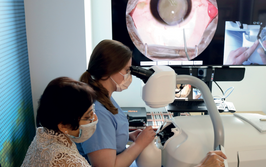
Extended Range of Patients
What kinds of patients are recommended an IC-8 lens by our expert panel?
sponsored by AcuFocus
The IC-8 IOL uses a unique method of action, small aperture optics, to correct vision for cataract patients. In general, the IC-8 IOL may be applied to cataract patients with up to 1.50 D pre-existing corneal astigmatism. Typically, it is used in combination with a small amount of monovision (-0.75 D): implanting the IC-8 lens in one eye preserves distance vision binocularity while achieving good near and intermediate vision – with less ametropia than required by monofocal monovision.
What kinds of patients are recommended an IC-8 lens by our expert panel?
Michael Shiu considers any patients suitable for a standard cataract operation to be a potential IC-8 IOL candidate, particularly if they want spectacle independence. “Age is not a limiting factor,” he says. Shiu also notes the benefits of an IC-8 IOL in young patients with traumatic cataract formation: “In these cases, monofocal IOLs are not appropriate, because the patients still need near vision. For these patients, I choose the IC-8 lens, even if their pupils are a bit larger than recommended for this IOL.” Outcomes, he says, are good; he has had no complaints of glare. Shiu adds: “One of them even achieved good vision with imperfect centration – I was very, very impressed!”
Beltz prefers to use the IC-8 IOL in combination with monovision: “Generally, I like to target between -0.75 and -1.00 D of myopia with the IC-8 IOL in the nondominant eye, whilst targeting emmetropia with a monofocal in the dominant eye.”
"Anyone with a decent, healthy looking macula is a potential IC-8 IOL candidate.” Boon Ham
Any other points? Sathish Srinivasan shared: “I have found for patients where power calculation is a problem, the small aperture IC-8 lens is quite forgiving – even when the refractive outcome is not perfect, the patient will have good distance, intermediate and near vision.” Vote notes that patients with HOA >0.3 and especially those with >0.5, who are not suitable for standard multifocal IOLs, are likely to benefit from the improved optics from the IC-8 IOL’s small aperture design. Auffarth agrees: “The IC-8 IOL is an important alternative to diffractive IOLs, as it is not associated with halo or glare issues in my experience.” Beltz notes that the IC-8 lens allows treatment of presbyopia in patients unsuitable for trifocal IOLs or unable to tolerate anisometropia or monovision. Shiu agrees: “If patients need very clear near vision, trifocals are good, but if they don’t want glare or halos the IC-8 IOL may be better – it depends on the patient’s requirements.” In summary, Chan states that the IC-8 lens gives him the option of offering spectacle independence to patients who are not candidates for other presbyopia correcting lens technology and would otherwise be limited to a monofocal IOL.
But there must be patients unsuited for the IC-8 IOL – what factors do our experts consider? Vote is clear: “Avoid eyes with central corneal scarring that overlaps the center aperture.” He also notes that he typically excludes patients with mesopic pupil sizes >6 mm as they are more likely to experience dysphotopsias, especially glare. Similarly, Shiu counsels avoiding eyes with with mesopic pupils larger than 5 mm (again, because the patients will likely experience halos and glare), and patients with macular pathology (because the IC-8 lens’ pinhole effect may reduce contrast too much). “I also avoid patients with severe glaucoma because of their existing issues with restricted visual field and contrast sensitivity,” says Shiu. Chan avoids monocular patients, patients with vitreous opacity, large or eccentric pupils, and those with retinal diseases such as AMD, advanced glaucoma, or significant diabetic retinopathy. Similarly, Auffarth cautions against implanting an IC-8 IOL in patients with very high need for near vision, severe retinal problems, glaucomatous damage, capsular rupture, pseudoexfoliation syndrome, or zonular weakness. Beltz suggests avoiding patients who don’t want to notice a difference between their eyes, and those at high risk of developing ocular diseases such as glaucoma, AMD, or DR.
Intended Use
The IC-8 IOL is intended for primary implantation for the visual correction of aphakia secondary to removal of a cataractous lens in adult patients with or without presbyopia, who desire near, intermediate and far vision with increased spectacle independence. The lens is intended for implantation in the capsular bag.
View the next article in the series
To view all parts of this series, go to The IC-8 IOL: Big Advantages Through Small Apertures
To download the full publication, please click here














